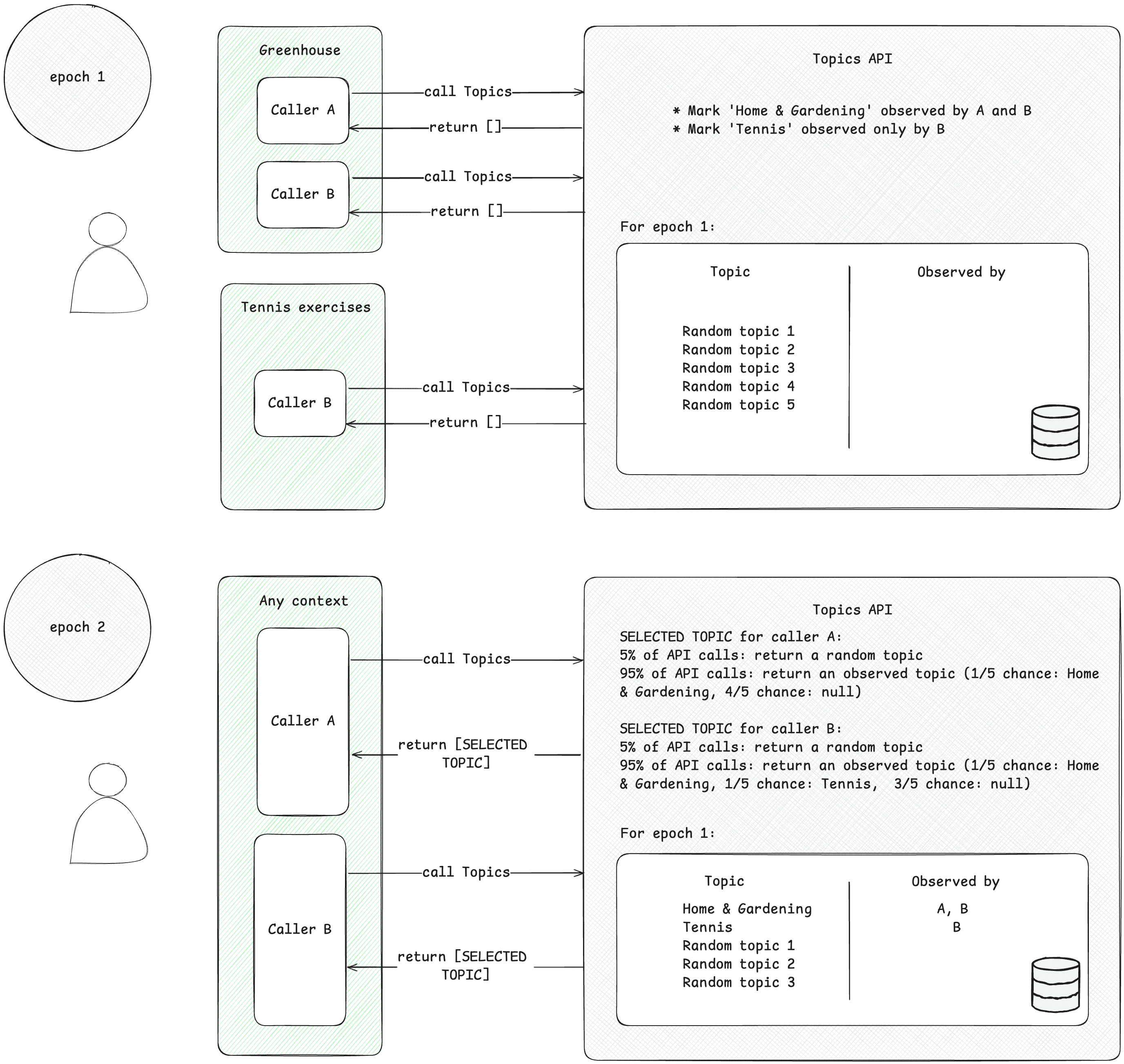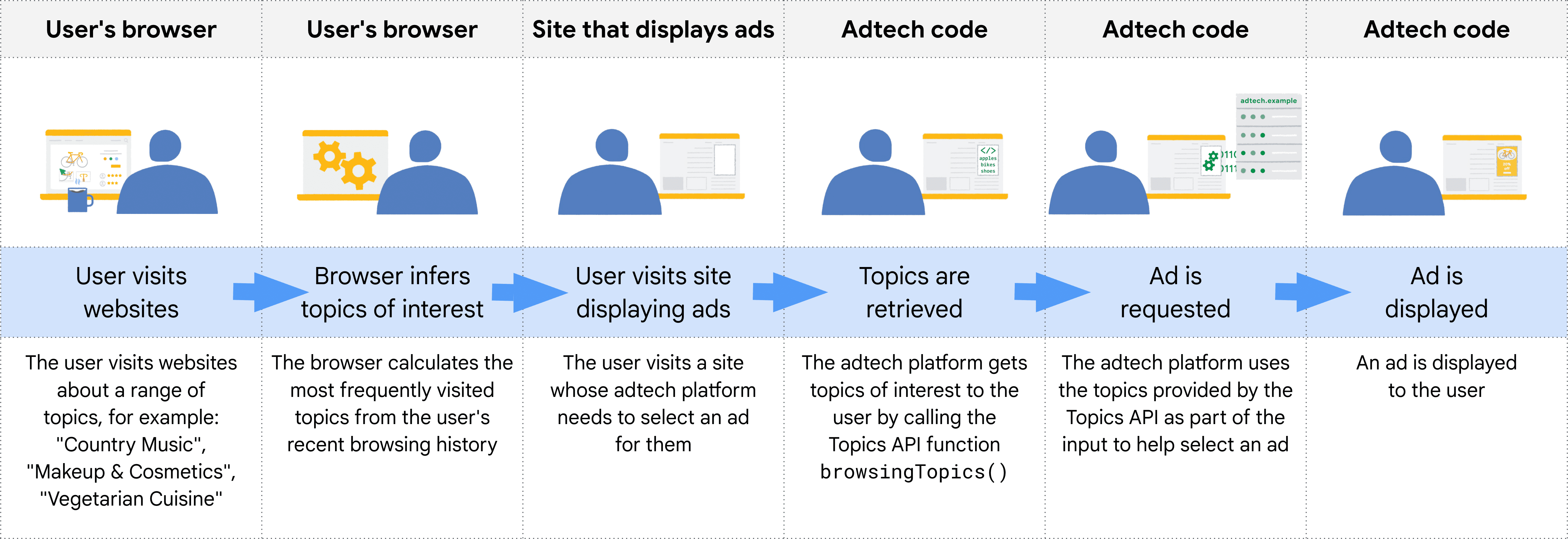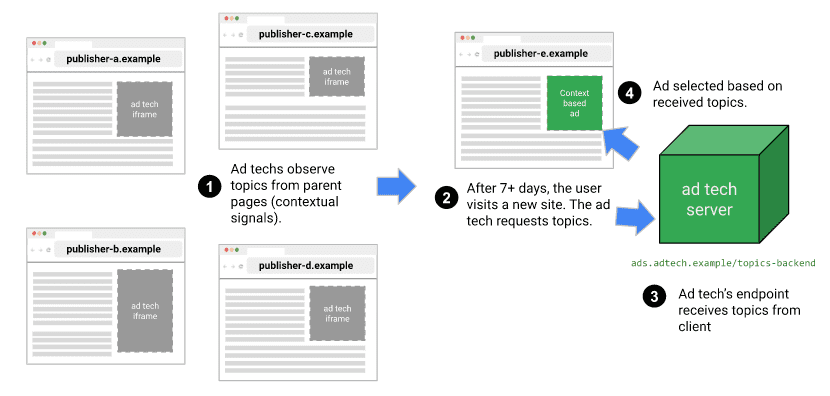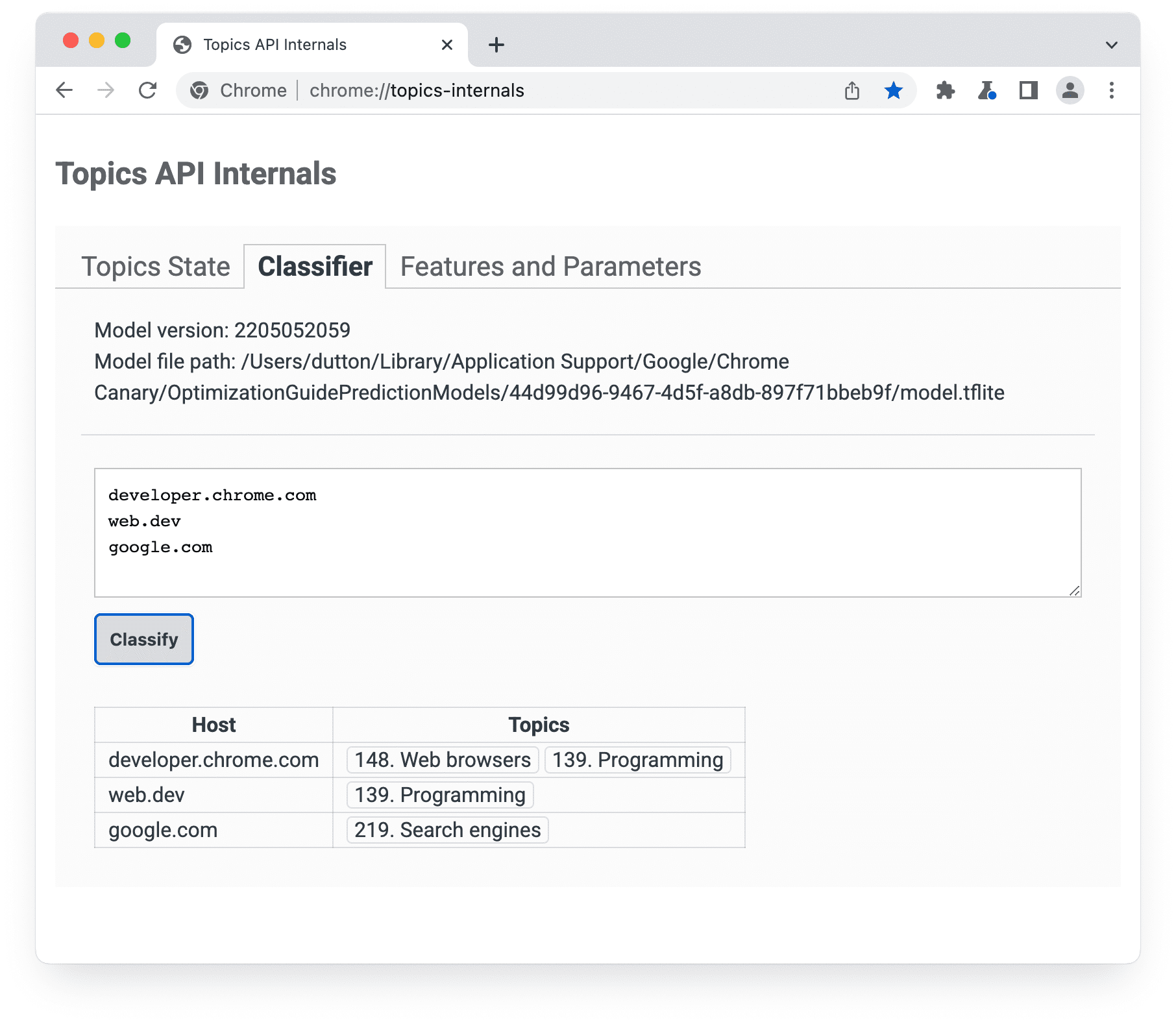বিষয় API তৃতীয় পক্ষের কুকিজ ব্যবহার না করেই আগ্রহ-ভিত্তিক বিজ্ঞাপন সক্ষম করে।
টপিক এপিআই কিভাবে কাজ করে
বিষয়বস্তু API ব্যবহারকারীর কার্যকলাপের উপর ভিত্তি করে ব্যবহারকারীর আগ্রহের বিষয়গুলি পর্যবেক্ষণ এবং অ্যাক্সেস প্রদান করতে ব্যবহার করা যেতে পারে। টপিক্স এপিআই তারপরে API কলারদের (যেমন বিজ্ঞাপন প্রযুক্তি প্ল্যাটফর্ম) ব্যবহারকারীর আগ্রহের বিষয়গুলিতে অ্যাক্সেস দিতে পারে, কিন্তু ব্যবহারকারীর কার্যকলাপ সম্পর্কে অতিরিক্ত তথ্য প্রকাশ না করে।
মূল ধারণা
- একটি বিষয় বর্তমান ব্যবহারকারীর জন্য আগ্রহের একটি মানব-পাঠযোগ্য বিষয় এবং এটি বিষয় শ্রেণীকরণের অংশ।
- একজন কলার হল একটি সত্তা, যেমন একটি অ্যাপ, একটি থার্ড-পার্টি SDK, একটি ওয়েবসাইট বা পরিষেবা, যা ব্যবহারকারীর আগ্রহগুলি পর্যবেক্ষণ বা অ্যাক্সেস করার জন্য বিষয় API-কে অনুরোধ করে৷
- একটি বিষয় একটি কলার দ্বারা পর্যবেক্ষণ করা হয়, যদি কলকারী গত তিনটি যুগে এই বিষয়ের সাথে যুক্ত একটি ওয়েব পৃষ্ঠা বা অ্যাপ থেকে একটি বিষয় API অনুরোধ করে।
- একটি যুগ হল বিষয় গণনার একটি সময়কাল, যা ডিফল্ট এক সপ্তাহ।
- শ্রেণীবিন্যাস হল বিভাগগুলির একটি অনুক্রমিক তালিকা, যার মধ্যে রয়েছে, উদাহরণস্বরূপ, যেমন
/Arts & Entertainment/Music & Audio/Soul & R&Bএবং/Business & Industrial/Business Services/Corporate Events। - বিষয়গুলি একটি ক্লাসিফায়ার মডেল ব্যবহার করে উদ্ভূত হয় যা ব্যবহারকারীর কার্যকলাপকে শূন্য বা তার বেশি বিষয়ে ম্যাপ করে।
বিষয় API প্রবাহ মূল পদক্ষেপ
টপিক এপিআই লাইফসাইকেলের তিনটি প্রধান ধাপ রয়েছে:
- ব্যবহারকারীর কার্যকলাপ পর্যবেক্ষণ করুন , যেমন যখন তারা ওয়েব পৃষ্ঠা
https://cats.example/tabby/index.htmlভিজিট করে বাcatsঅ্যাপ ডাউনলোড করে। - ব্যবহারকারীর কার্যকলাপ থেকে বিষয়গুলি আহরণ করুন , উদাহরণস্বরূপ
/Pets & Animals/Pets/Cats। - ব্যবহারকারীর জন্য পূর্বে পর্যবেক্ষণ করা বিষয়গুলি অ্যাক্সেস করুন , উদাহরণস্বরূপ প্রাসঙ্গিক বিজ্ঞাপন নির্বাচন করার জন্য একটি সংকেত হিসাবে (যেমন একটি বিড়াল খাবার প্রচার)।
বিষয়গুলি পর্যবেক্ষণ করুন
কলাররা শুধুমাত্র আগ্রহের বিষয়গুলি অ্যাক্সেস করতে পারে যা তারা পর্যবেক্ষণ করেছে ৷ একজন কলার একটি বিষয় পর্যবেক্ষণ করেন যখন তারা এই বিষয়ের সাথে সম্পর্কিত একটি প্রসঙ্গ থেকে একটি বিষয় API অনুরোধ করেন। এই ধারণাটি ব্যাখ্যা করার জন্য, নিম্নলিখিত সরলীকৃত উদাহরণটি বিবেচনা করুন।
- ধরুন দুটি বিষয় API কলার আছে: A এবং B।
- দুটি প্রসঙ্গ আছে:
- গ্রীনহাউস , উদাহরণস্বরূপ গ্রীনহাউস নামের একটি অ্যাপ বা একটি ওয়েবসাইট greenhouse.example,
Home & Gardenবিষয়ের সাথে যুক্ত। - টেনিস ব্যায়াম , উদাহরণস্বরূপ টেনিস এক্সারসাইজ নামের একটি অ্যাপ বা একটি ওয়েবসাইট tennis.example,
Sports/Tennisবিষয়ের সাথে যুক্ত।
- গ্রীনহাউস , উদাহরণস্বরূপ গ্রীনহাউস নামের একটি অ্যাপ বা একটি ওয়েবসাইট greenhouse.example,
- কলার A এবং B উভয়ই গ্রীনহাউসের প্রসঙ্গে উপস্থিত।
- টেনিস অনুশীলনের প্রেক্ষাপটে শুধুমাত্র কলার B উপস্থিত থাকে।
- অনুমান করুন যে epoch 1 এর আগে ব্যবহারকারীর জন্য সরলীকরণের খাতিরে কোনো বিষয় পর্যবেক্ষণ করা হয়নি।
- ব্যবহারকারী গ্রীনহাউস অ্যাপে যান, এবং কলার A এবং B একটি টপিক এপিআই কল করে পৃষ্ঠা বা অ্যাপে ব্যবহারকারীর ভিজিট রেকর্ড করতে (কীভাবে টপিক এপিআই কল করতে হয় তা জানতে পরবর্তী ধাপে প্রস্তাবিত বাস্তবায়ন নির্দেশিকা দেখুন)। এই রেকর্ডটি (একটি হোস্টনাম বা অ্যাপ ডেটা) পরে আগ্রহের বিষয়গুলি বের করতে ব্যবহৃত হয়। টপিক এপিআই পরবর্তীতে কলার A এবং B উভয়ের দ্বারা পর্যবেক্ষণকৃত
Home & Gardenবিষয়টিকে চিহ্নিত করবে। - ব্যবহারকারী টেনিস অনুশীলন অ্যাপ্লিকেশন পরিদর্শন. শুধুমাত্র কলার B একটি বিষয় API অনুরোধ পাঠায়। টপিকস এপিআই পরে
Sports/Tennisবিষয়টিকে চিহ্নিত করবে যেমনটি কলার B দ্বারা পর্যবেক্ষণ করা হয়েছে। - যুগের শেষের দিকে, বিষয় API ব্যবহারকারীর শীর্ষ বিষয়গুলিকে রিফ্রেশ করে এবং ব্যবহারকারীর কার্যকলাপের উপর ভিত্তি করে এই বিষয়গুলি পর্যবেক্ষণকারী কলারদের নির্ধারণ করে৷
- পরে, যখন কলার B অন্য টপিক API কল করে, তখন সে প্রতিক্রিয়া অ্যারেতে এই ব্যবহারকারীর জন্য
Home & GardenবাSports/Tennisবিষয় (বা 5% সুযোগ সহ, একটি এলোমেলো বিষয়) পেতে পারে। - কলার A শুধুমাত্র
Home & Gardenটপিক অ্যাক্সেস করতে পারে, কারণ সে কখনোইSports/Tennisটপিক দেখেনি। এর মানে হল যে কোনও তৃতীয়-পক্ষ শুধুমাত্র সেই নির্দিষ্ট প্রেক্ষাপটে (অ্যাপ বা ওয়েবসাইট) যেখানে এটি উপস্থিত রয়েছে সেখানে ব্যবহারকারীর আগ্রহের বিষয় সম্পর্কে জানতে পারবে।

প্রসঙ্গ আহরণ
বিষয়গুলি ব্যবহারকারীর কার্যকলাপ থেকে আগ্রহের বিষয়গুলি অর্জন করে৷ বিষয়গুলি একটি পূর্বনির্ধারিত ওপেন সোর্স শ্রেণীবিন্যাস থেকে নির্বাচন করা হয়েছে। একবার প্রতি যুগে , বিষয়গুলি ব্যবহারকারীর শীর্ষ পাঁচটি বিষয় এবং সেই যুগের সময় তাদের পর্যবেক্ষণকারী কলারগুলিকে রিফ্রেশ করে৷ টপিক ক্লাসিফায়ার মডেলটি ব্যবহারকারীর কার্যকলাপ থেকে বিষয়গুলি নিয়ে আসে: একটি ওয়েব পৃষ্ঠা দেখার জন্য হোস্টনাম, Android এ অ্যাপের তথ্য ৷
কলার ব্যবহারকারীর আগ্রহের বিষয়গুলি অ্যাক্সেস করে৷
এপিআই কেবলমাত্র সেই বিষয়গুলি ফেরত দেয় যা কলকারীর দ্বারা সাম্প্রতিক তিনটি যুগের মধ্যে পর্যবেক্ষণ করা হয়েছে৷ একজন কলারকে সর্বাধিক তিনটি বিষয় ফেরত দেওয়া যেতে পারে, তিনটি সাম্প্রতিক যুগের প্রতিটির জন্য একটি বিষয় (যদি কলকারী সেই যুগের বিষয়গুলি পর্যবেক্ষণ করেন)। প্রত্যাবর্তিত বিষয়গুলি কলকারী যে কোনও প্রাসঙ্গিক তথ্যের পরিপূরক করতে ব্যবহার করতে পারে এবং ব্যবহারকারীর জন্য আরও প্রাসঙ্গিক বিজ্ঞাপন খুঁজে পেতে সহায়তা করতে একত্রিত করা যেতে পারে।
যুগ
টপিক এপিআই নিশ্চিত করতে হবে যে এটি প্রদান করে আগ্রহের বিষয়গুলি আপ টু ডেট রাখা হয়েছে। ডিফল্টরূপে এক সপ্তাহ, একটি যুগ হিসাবে পরিচিত সময়কালে ব্যবহারকারীর কার্যকলাপের উপর ভিত্তি করে বিষয়গুলি অনুমান করা হয়৷ প্রতিটি ব্যবহারকারীর নিজস্ব যুগ রয়েছে (যুগগুলি "প্রতি ব্যবহারকারী") এবং প্রাথমিক শুরুর সময় এলোমেলো করা হয়।
একবার প্রতিটি যুগে, বিষয় API ব্যবহারকারীর শীর্ষ পাঁচটি বিষয় গণনা করে এবং ডিভাইসের তথ্য ব্যবহার করে কোন কলকারীরা সেই বিষয়গুলি পর্যবেক্ষণ করেছে তা নির্ধারণ করে। প্রতিটি যুগের জন্য নির্বাচিত বিষয়টি সেই সময়ের জন্য ব্যবহারকারীর শীর্ষ পাঁচটি বিষয় থেকে এলোমেলোভাবে নির্বাচিত হয়। গোপনীয়তা আরও উন্নত করতে এবং সমস্ত বিষয়ের প্রতিনিধিত্ব করা যেতে পারে তা নিশ্চিত করতে, আগ্রহের শ্রেণীবিভাগে সমস্ত সম্ভাব্য বিষয়গুলি থেকে এলোমেলোভাবে বিষয় নির্বাচন করার 5% সম্ভাবনা রয়েছে৷
অনুশীলনে ওয়েবে বিষয়
ওয়েবে, ব্যবহারকারীর পরিদর্শন করা পৃষ্ঠাগুলির হোস্টনাম থেকে বিষয়গুলি অনুমান করা হয়৷ উদাহরণস্বরূপ, dogs.example ওয়েবসাইটের জন্য অনুমান করা বিষয় হতে পারে /Pets & Animals/Pets/Dogs ।
নিম্নলিখিত চিত্রটি একটি সরলীকৃত উদাহরণ দেখায় তা দেখানোর জন্য যে বিষয় API কীভাবে একটি বিজ্ঞাপন প্রযুক্তি প্ল্যাটফর্মকে একটি উপযুক্ত বিজ্ঞাপন নির্বাচন করতে সাহায্য করতে পারে৷ উদাহরণটি অনুমান করে যে ব্যবহারকারীর ব্রাউজারে ইতিমধ্যেই বিষয়গুলিতে ওয়েবসাইট হোস্টনাম ম্যাপ করার জন্য একটি মডেল রয়েছে৷

ব্রাউজারটি টপিকস এপিআই কল করে এমন কোডের প্রেক্ষাপট থেকে কলারের উত্স নির্ধারণ করে। বাস্তবে, এর মানে হল যে টপিক ব্যবহারকারীরা তাদের মূল থেকে একটি আইফ্রেমে API কল করে অথবা তারা তাদের মূলে নিয়ে আসা বিষয়গুলি অন্তর্ভুক্ত করে।
উদাহরণস্বরূপ, একটি সাপ্লাই-সাইড প্ল্যাটফর্ম (SSP) একাধিক প্রকাশকের সাইটে এম্বেড করা যেতে পারে। এসএসপি তখন তার মূল থেকে একটি আইফ্রেমের মধ্যে বিষয় API কল করতে পারে, এটি সেই প্রকাশকের সাইটগুলিতে ব্যবহারকারীর সাথে সম্পর্কিত বিষয়গুলি পর্যবেক্ষণ করার অনুমতি দেয়। ব্যবহারকারীর জন্য একটি প্রাসঙ্গিক বিজ্ঞাপন নির্বাচন করতে সাহায্য করার জন্য এই বিষয়গুলি একটি ডিমান্ড-সাইড প্ল্যাটফর্মের (DSP) সাথে ভাগ করা যেতে পারে।
এপিআই কীভাবে সিদ্ধান্ত নেয় কোন কলকারীরা কোন বিষয়গুলি দেখবে
API কলকারীরা শুধুমাত্র সেই বিষয়গুলি গ্রহণ করে যা তারা সম্প্রতি পর্যবেক্ষণ করেছে, এবং ব্যবহারকারীর জন্য বিষয়গুলি প্রতিটি যুগে একবার রিফ্রেশ করা হয়: একটি সময়কাল, Chrome এর বাস্তবায়নে এক সপ্তাহে সেট করা হয়৷ তার মানে API একটি রোলিং উইন্ডো প্রদান করে যেখানে একজন প্রদত্ত কলকারী পর্যবেক্ষণ করা বিষয়গুলি পেতে পারে।
নিম্নলিখিত সারণীটি একটি একক যুগে একজন ব্যবহারকারীর জন্য একটি অনুমানমূলক ব্রাউজিং ইতিহাসের একটি উদাহরণ (যদিও অবাস্তবভাবে ছোট) রূপরেখা দেয়, তারা যে সাইটগুলি পরিদর্শন করেছে তার সাথে সম্পর্কিত বিষয়গুলি এবং প্রতিটি সাইটে উপস্থিত API কলাররা (সাইটে অন্তর্ভুক্ত জাভাস্ক্রিপ্ট কোডে document.browsingTopics() কল করে)।
| সাইট | বিষয় | সাইটে API কলার |
|---|---|---|
| run.example | Running & WalkingAthletic Shoes | adtech1.example adtech2.example |
| dogs.example | Dogs | adtech1.example |
| ছুটির উদাহরণ | Hotels & Accommodations | adtech2.example |
| sunglasses.example | Sunglasses | [কোনটিই নয়] |
যুগের শেষে (ডিফল্টভাবে এক সপ্তাহ) টপিক এপিআই সপ্তাহের জন্য ব্রাউজারের শীর্ষ বিষয়গুলি তৈরি করে।
- adtech1.example এখন
Running & Walking,Athletic ShoesএবংDogsবিষয়গুলি পাওয়ার যোগ্য, কারণ এটি রানিং.উদাহরণ এবং dogs.example-এও তাদের পর্যবেক্ষণ করেছে৷ - adtech1.example এই ব্যবহারকারীর জন্য
Hotels & Accommodationsবিষয় পাওয়ার যোগ্য নয় কারণ এটি সেই বিষয়ের সাথে যুক্ত ব্যবহারকারী সম্প্রতি পরিদর্শন করা কোনো সাইটে উপস্থিত নয়। - adtech2.example
Running & Walking,Athletic ShoesএবংHotels & Accommodationsবিষয়গুলি দেখেছে, কিন্তুDogsবিষয় দেখেনি৷
ব্যবহারকারী sunglasses.example পরিদর্শন করেছেন, যার Sunglasses বিষয় রয়েছে, কিন্তু সেই সাইটে টপিক এপিআই-তে কোনো কল নেই। এই মুহুর্তে, এর অর্থ হল Sunglasses বিষয়টি API দ্বারা কোনো কলারের জন্য ফেরত দেওয়া হবে না।
দুই সপ্তাহে, ব্যবহারকারী অন্য সাইটে যান:
| সাইট | বিষয় | সাইটে API কলার |
|---|---|---|
| cameras.example | Camera & Photo Equipment | adtech2.example |
উপরন্তু, adtech2.example থেকে কোড sunglasses.example এ যোগ করা হয়েছে:
| সাইট | বিষয় | সাইটে API কলার |
|---|---|---|
| sunglasses.example | Sunglasses | adtech2.example |
পাশাপাশি Running & Walking , Athletic Shoes এবং Hotels & Accommodations 1 সপ্তাহ থেকে, এর অর্থ হল adtech2.example এখন Camera & Photo Equipment এবং Sunglasses বিষয়গুলি গ্রহণ করতে সক্ষম হবে — তবে পরবর্তী যুগ, সপ্তাহ 3 পর্যন্ত নয়। এটি নিশ্চিত করে যে তৃতীয় পক্ষগুলি কোনও ব্যবহারকারীর অতীত সম্পর্কে আরও বেশি শিখতে পারবে না (এই ক্ষেত্রে তারা ফ্যাশনে রান্না করতে পারে)।
আরও দুই সপ্তাহ পরে, Running & Walking , Athletic Shoes এবং Hotels & Accommodations adtech2.example-এর যোগ্য বিষয়গুলির তালিকা থেকে বাদ পড়তে পারে যদি ব্যবহারকারী adtech2.example-এর কোড অন্তর্ভুক্ত করে এমন বিষয়গুলির সাথে কোনও সাইট পরিদর্শন না করেন৷

ক্লাসিফায়ার মডেল
বিষয়গুলি একটি ক্লাসিফায়ার মডেল ব্যবহার করে যা ওয়েবসাইটের হোস্টনামগুলিকে শূন্য বা তার বেশি বিষয়ে ম্যাপ করে (অতিরিক্ত তথ্য বিশ্লেষণ করা, যেমন সম্পূর্ণ URL বা পৃষ্ঠার বিষয়বস্তু, আরও প্রাসঙ্গিক বিজ্ঞাপনের জন্য অনুমতি দিতে পারে, তবে গোপনীয়তাও হ্রাস করতে পারে)।
শ্রেণীবিন্যাস
একটি শ্রেণীবিন্যাস থেকে বিষয় নির্বাচন করা হয়. এই বিষয়গুলি Chrome দ্বারা কিউরেট করা হয়েছে, এই লক্ষ্যে যে শ্রেণীবিন্যাস বিশ্বস্ত ইকোসিস্টেম অবদানকারীদের দ্বারা রক্ষণাবেক্ষণ করা একটি সংস্থান হয়ে ওঠে৷ শ্রেণীবিন্যাস যথেষ্ট ছোট হতে হবে যাতে অনেক ব্যবহারকারীর ব্রাউজার প্রতিটি বিষয়ের সাথে যুক্ত হবে। চূড়ান্ত লক্ষ্য হল শ্রেণীবিন্যাস একটি বাহ্যিক পক্ষ থেকে উৎসারিত করা যা শিল্প জুড়ে প্রতিক্রিয়া এবং ধারণাগুলিকে অন্তর্ভুক্ত করে।
সংবেদনশীল বিভাগগুলি এড়াতে, বিষয়গুলি অবশ্যই সর্বজনীন, মানব-নিয়োজিত এবং আপ টু ডেট থাকতে হবে৷ ক্রোম দ্বারা ব্যবহৃত শ্রেণীবিন্যাসটি সাধারণত সংবেদনশীল হিসাবে বিবেচিত বিভাগগুলি বাদ দেওয়ার জন্য মানব-নিয়োজিত করা হয়েছে, যেমন জাতিগততা বা যৌন অভিযোজন।
বিষয় শ্রেণীবিভাগ
50,000টি শীর্ষ সাইটের জন্য বিষয়গুলি ম্যানুয়ালি কিউরেট করা হয় এবং হোস্টনাম এবং বিষয়গুলির এই কিউরেটেড ওভাররাইড তালিকাটি ক্লাসিফায়ার মডেলকে প্রশিক্ষণ দিতে ব্যবহৃত হয়। শীর্ষস্থানীয় সাইটগুলির জন্য, ক্লাসিফায়ার মডেল ব্যবহার করার পরিবর্তে ওভাররাইড তালিকা থেকে বিষয়গুলি অ্যাক্সেস করা হয়। আপনি আপনার কম্পিউটারে স্থানীয়ভাবে ওভাররাইড তালিকা দেখতে পারেন।

chrome://topics-internals পৃষ্ঠা ক্লাসিফায়ার প্যানেল মডেল সংস্করণ, এর পথ এবং তালিকাভুক্ত প্রতিটি হোস্টের সাথে সম্পর্কিত বিষয়গুলিকে তালিকাভুক্ত করে৷Chrome-এর টপিক API-এর বাস্তবায়ন মডেলের প্রতিনিধিত্বকারী একটি TensorFlow Lite ফাইল ডাউনলোড করে যাতে এটি ব্যবহারকারীর ডিভাইসে স্থানীয়ভাবে ব্যবহার করা যায়।
কিভাবে ব্যবহারকারীর সেরা পাঁচটি বিষয় নির্বাচন করা হয়
API প্রতিটি যুগের জন্য একটি বিষয় প্রদান করে, সর্বোচ্চ তিনটি পর্যন্ত। যদি তিনটি প্রত্যাবর্তন করা হয়, এতে বর্তমান যুগ এবং পূর্ববর্তী দুটি বিষয় অন্তর্ভুক্ত রয়েছে।
- প্রতিটি যুগের শেষে, ব্রাউজার নিম্নলিখিত মানদণ্ড পূরণ করে এমন পৃষ্ঠাগুলির একটি তালিকা সংকলন করে:
- পৃষ্ঠাটি যুগের সময় ব্যবহারকারী দ্বারা পরিদর্শন করা হয়েছিল।
- পৃষ্ঠায় কোড রয়েছে যা
document.browsingTopics()কে কল করে। - API সক্রিয় করা হয়েছে (উদাহরণস্বরূপ, ব্যবহারকারীর দ্বারা বা একটি প্রতিক্রিয়া শিরোনাম দ্বারা অবরুদ্ধ নয়)।
- ব্রাউজার, ব্যবহারকারীর ডিভাইসে, বিষয়গুলির একটি তালিকায় প্রতিটি পৃষ্ঠার হোস্টনাম ম্যাপ করতে বিষয় API দ্বারা প্রদত্ত ক্লাসিফায়ার মডেল ব্যবহার করে৷
ব্রাউজারটি শীর্ষ পাঁচটি বিষয়ের একটি তালিকা তৈরি করে।
- শ্রেণীবিন্যাসে 22টি মূল বিষয়গুলির প্রত্যেকটিকে বিজ্ঞাপন বাস্তুতন্ত্রের প্রতিক্রিয়ার উপর ভিত্তি করে একটি "উচ্চ উপযোগিতা" বা "স্ট্যান্ডার্ড ইউটিলিটি" বালতিতে বরাদ্দ করা হয়। ব্রাউজার প্রথমে তাদের বালতি অ্যাসাইনমেন্ট দ্বারা বিষয় বাছাই করে। সমস্ত বংশধর বিষয়গুলি তাদের মূল মূল বিষয়ের বাকেট অ্যাসাইনমেন্টের উত্তরাধিকারী হয়৷ "উচ্চ উপযোগিতা" বিষয়গুলিকে অগ্রাধিকার দেওয়া হয়৷
- ব্রাউজার তারপর প্রতিটি বালতির মধ্যে ফ্রিকোয়েন্সি দ্বারা বিষয় বাছাই.
- এই বাছাই করা তালিকা থেকে শীর্ষ পাঁচটি বিষয়কে সেই যুগের জন্য ব্যবহারকারীর শীর্ষ বিষয় হিসাবে নির্বাচিত করা হয়েছে।
তারপর document.browsingTopics() পদ্ধতিটি প্রতিটি যুগের জন্য শীর্ষ পাঁচটি থেকে একটি এলোমেলো বিষয় ফেরত দেয়, 5% সম্ভাবনা থাকে যে এইগুলির যেকোনও বিষয়ের সম্পূর্ণ শ্রেণীবিন্যাস থেকে এলোমেলোভাবে নির্বাচিত হতে পারে। ক্রোমে, ব্যবহারকারীরা পৃথক বিষয়গুলি সরাতে বা API দ্বারা প্রত্যাবর্তিত বিষয়গুলির সংখ্যা কমাতে তাদের ব্রাউজিং ইতিহাস সাফ করতেও সক্ষম। ব্যবহারকারীরা API থেকে অপ্ট আউটও করতে পারেন।
আপনি chrome://topics-internals পৃষ্ঠা থেকে বর্তমান যুগে পর্যবেক্ষণ করা বিষয় সম্পর্কে তথ্য দেখতে পারেন।
পরবর্তী পদক্ষেপ
সেটআপ
বিষয়গুলি বাস্তবায়ন করুন
এছাড়াও দেখুন
ওয়েবে টপিক এপিআই আরও ভালভাবে বুঝতে আমাদের সংস্থানগুলি দেখুন।
- টপিক ডেমো, সহযোগিতা এবং ওয়াকথ্রু ভিডিও দেখুন।
- ক্রোম পতাকাগুলির তালিকা দেখুন যা বিকাশকারীদের পরীক্ষার জন্য বিষয় API কাস্টমাইজ করার অনুমতি দেয়৷
- ব্যবহারকারী এবং বিকাশকারীরা কীভাবে API নিয়ন্ত্রণ করতে পারে তা দেখুন।
- প্রযুক্তিগত ব্যাখ্যাকারী এবং সহায়তার জন্য সংস্থানগুলি দেখুন। প্রশ্ন জিজ্ঞাসা করুন, জড়িত এবং প্রতিক্রিয়া শেয়ার করুন.



